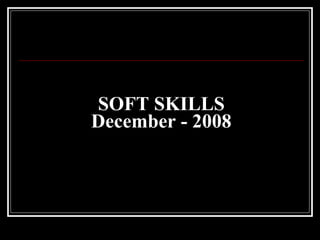Signaler
Partager

Contenu connexe
Tendances (20)
En vedette
En vedette (8)
Similaire à Soft Skills
Similaire à Soft Skills (20)
HOW TO MASTER GOOD COMMUNICATION SKILLS AND CONFIDENCE

HOW TO MASTER GOOD COMMUNICATION SKILLS AND CONFIDENCE
Soft Skills
- 1. SOFT SKILLS December - 2008
- 10. Communication is a Series of Experiences of Hearing Seeing Smell Touch Taste
- 17. Communication: Speaking Body language Voice quality Intention Manner: directness, sincerity Dress and clothing (style, color, appropriateness for situation) Visual aids, animation Eye contact Emotional content, energy, strength Self-concept Concept of others Listening, hearing the underlying message Speaking from the heart Energy Setting, time, place, timing How the messenger holds the message Sensitivity Rhythm and pacing Attitude and confidence Rapport Agenda Purpose of communication - knowing what you want to communicate Clarity Silence, centering, looking
- 36. First Impression Test – Women Who would you hire?
- 37. First Impression Test – Men Who would you hire?
- 46. Negotiation Skills
- 57. Think about your influencing style Inspirational Logical Personal Forceful
- 62. E-Mail Etiquette
- 71. Questions?